Throwback Thursday: The Whole Story on Dark Matter
When things don’t add up, it’s a great sign that something amazing is right around the corner.
Every Thursday, we take an older post from the Starts With A Bang archives and update it for the present day. After yesterday’s post on The Death of Dark Matter’s #1 Competitor, there was no better choice than to tell you the whole story on the most mysterious, ubiquitous source of matter permeating our Universe.
“Science progresses best when observations force us to alter our preconceptions.” –Vera Rubin
I want you to think about the Universe. The whole thing; about everything that physically exists, both visible and invisible, about the laws of nature that they obey, and about your place in it.
It’s a daunting, terrifying, and simultaneously beautiful and wondrous thing, isn’t it?

After all, we spend our entire lives on one rocky world, that’s just one of many planets orbiting our Sun, which is just one star among hundreds of billions in our Milky Way galaxy, which is just one galaxy among hundreds of billions that make up our observable Universe.
Yes, we’ve learned an awful lot about what’s out there and our place in it. As best as we can tell, we’ve learned what the fundamental laws are that govern everything in it, too!

As far as gravitation goes, Einstein’s theory of general relativity explains everything from how matter and energy bend starlight to why clocks run slow in strong gravitational fields to how the Universe expands as it ages. It is arguably the most well-tested and vetted scientific theory of all time, and every single one of its predictions that has ever been precision-tested has been verified to be spot-on.

On the other hand, we’ve got the standard model of elementary particles and interactions, which explains everything known to exist in the Universe, and all the other (nuclear and electromagnetic) forces that they experience. This, also, is arguably the most well-tested and vetted scientific theory of all time.
And you would think that if our understanding of things were perfect, if we knew all about the structure of the Universe, the matter in it, and the laws of physics that it obeyed, we’d be able to explain everything. Why? Because all you’d have to do is start out with some set of initial conditions — immediately following the Big Bang — for all the particles in the Universe, apply those laws of nature that we know, and see what it turns into over time! It’s a hard problem, but in theory, it should be not only possible to simulate, it should give us a sample Universe that looks just like the one we have today.

But this isn’t what happens. In fact, this can’t be the way it happens at all. This picture I painted for you above is all true, on the one hand, but we also know that it isn’t the whole story. There are other things going on that we don’t fully understand.
Here, as best as I can present the full history in a single blog post, is the whole story.
As we come forward from the event of the Big Bang, our Universe expands and cools, while the entire time it experiences the irresistible force of gravity. Over time, a number of extremely important events happen, including, in chronological order:
- the formation of the first stable atomic nuclei,
- the formation of the first neutral atoms,
- the formation of stars, galaxies, clusters, and large-scale structure,
- and the slowing expansion of the Universe over its entire history.
If we know what’s fundamentally in the Universe and the physical laws that everything obeys, we’ll arrive at quantitative predictions for all of these things, including:
- what nuclei form and when they do so in the early Universe,
- what the radiation from the last-scattering-surface, when the first neutral atoms are formed, looks like in great detail,
- what the structure of the Universe, from large scales down to small scales, looks like both today and at any moment in the Universe’s past,
- and how the scale, size, and number of objects in the observable Universe have evolved over its history.
We have made observations measuring all four of these things, quantitatively, extremely well. Here’s what we’ve learned.

What we consider to be normal matter, that is, stuff made up of proton, neutrons and electrons, is highly constrained by a variety of measurements. Before any stars formed, the nuclear furnace of the very early Universe fused the first protons and neutrons together in very specific ratios, depending on how much matter and how many photons there were at the time.
What our measurements tell us, and they’ve been verified directly, is exactly how much normal matter there is in the Universe. This number is incredibly tightly constrained to be — in terms that might be familiar to you — about 0.262 protons + neutrons per cubic meter. There could be 0.28, or 0.24, or some other number in that range, but there really couldn’t be more or less than that; our observations are too solid. (And since we know the size of the Universe today, we know the mean density of normal matter!)

After that, the Universe continues to expand and cool, until eventually the photons in the Universe — which outnumber the nuclei by more than a billion-to-one — lose enough energy that neutral atoms can form without immediately being blasted apart.
When these neutral atoms finally form, the photons are free to travel, uninhibited, in whatever direction they happened to be moving last. Billions of years later, that leftover glow from the Big Bang — those photons — are still around, but they’ve continued to cool, and are now in themicrowave portion of the electromagnetic spectrum. First observed in the 1960s, we’ve now not only measured this Cosmic Microwave Background, we’ve measured the tiny temperature fluctuations — microKelvin-scale fluctuations — that exist in it.

These temperature fluctuations, and the magnitudes, correlations and scales on which they appear, can give us an incredible amount of information about the Universe. In particular, one of the things they can tell us is what the ratio of total matter in the Universe is to the ratio of normal matter. We would see a very particular pattern if that number were 100%, and the pattern we do see looks nothing like that.
Here’s what we find.

The necessary ratio to achieve this particular patter of wiggles is about 5:1, meaning that only about 16% of the matter in the Universe can be normal matter. This doesn’t tell us anything what this other 84% is, except that it isn’t the same stuff we’re made out of. From the Cosmic Microwave Background alone, we only know that it exerts a gravitational influence like normal matter, but it doesn’t interact with electromagnetic radiation (photons) like normal matter does.
You can also imagine that we’ve got something wrong about the laws of gravity; that there’s some modification we can make to it to mimic this effect that we can re-create by putting in dark matter. We don’t know what sort of modification could do that (we haven’t successfully found one, yet), but it is conceivable that we’ve just got the laws of gravity wrong. If a modified theory of gravity could explain the fluctuations of in the Microwave Background without any dark matter at all, that would be incredibly interesting.
But if there really is dark matter, it could be something light, like a neutrino, or something very heavy, like a theorized WIMP. It could be something fast-moving, with a lot of kinetic energy, or it could be something slow-moving, with practically none. We just know that all of the matter can’t be the normal stuff we’re used to, and that we’ve come to expect. But we can learn more about it by simulating how structure — stars, galaxies, clusters, and large-scale structure — forms in the Universe.
Because the types of structures you get out — including what types of galaxies, clusters, gas clouds, etc. — exist at all times in the Universe’s history. These differences don’t show up in the Cosmic Microwave Background, but they do show up in the structures that form in the Universe.
What we do is take a look at the galaxies that form in the Universe and see how they cluster together: how far away from a galaxy do I have to look before I see a second galaxy? How early in the Universe do large galaxies and clusters form? How quickly do the first stars and galaxies form? And what can we learn about the matter in the Universe from this?

Because if the dark matter — which doesn’t interact with light or normal matter — has lots of kinetic energy, it will delay the formation of stars, galaxies, and clusters. If the dark matter has some but not too much, it makes it easier to form clusters, but still hard to form stars and galaxies early on. If the dark matter has virtually none, we should form stars and galaxies early. Also, the more dark matter there is (relative to normal matter), the more smooth the correlations will be between galaxies on different scale, while the less dark matter there is means that the differences in correlations between different scales will be very stark.
The reason for this is that early on, when clouds of normal matter starts to contract beneath the force of gravity, the radiation pressure increases, causing the atoms to “bounce back” on certain scales. But dark matter, being invisible to photons, wouldn’t do this. So if we see how big these “bouncing features” are, known as baryon acoustic oscillations, we can learn whether there’s dark matter or not, and — if it’s there — what its properties are. The thing we construct, if we want to see this, is just as powerful as the graph of the fluctuations in the microwave background, a couple of images above. It’s the much lesser-known but equally important Matter Power Spectrum, shown below.
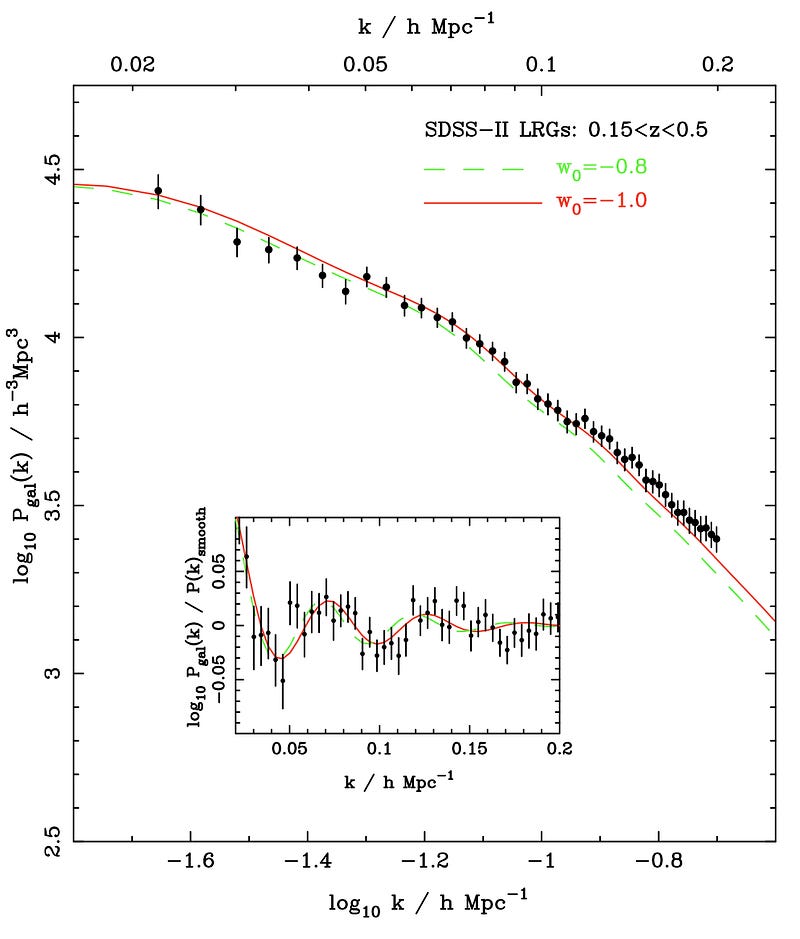
As you can clearly see, we do see these “bouncing” features, as those are the wiggles in the curve, above. But they’re small bounces, consistent with 15-to-20% of the matter being “normal” matter and the vast majority of it being smooth, “dark” matter. Again, you might wonder if there isn’t some way we could modify gravity to account for this type of measurement, rather than introducing dark matter. We haven’t found one yet, but if such a modification were found, it would be awfully compelling. But we’d have to find a modification that works for both the matter power spectrum and the cosmic microwave background, the way that a Universe where 80% of the matter is dark matter works for both.
This is from the structure data on large scales; we can also look on small scales, and see whether small clouds of gas, in-between us and very distant, bright objects from the early Universe, are thoroughly gravitationally collapsed or not; we look at the Lyman-alpha forest for this.

These intervening, ultra-distant clouds of hydrogen gas teach us that, if there is dark matter, it must have very little kinetic energy. So this tells us that either the dark matter was born somewhat cold, without very much kinetic energy, or it’s very massive, so that the heat from the early Universe wouldn’t have much of an effect on the speed it was moving millions of years later on. In other words, as much as we can define a temperature for dark matter, assuming it exists, it’s on the cold side.
But we also need to explain the smaller-scale structures that we have today, and examine in gory detail. This means when we look at galaxy clusters, they, too, should be made of 80-85% dark matter and 15-20% normal matter. The dark matter should exist in a big, diffuse halo around the galaxies and the clusters. The normal matter should be in a couple of different forms: the stars, which are extremely dense, collapsed objects, and the gas, diffuse (but denser than the dark matter) and in clouds, populating the interstellar and intergalactic medium. Under normal circumstances, the matter — normal and dark — is all held together, gravitationally. But every once in a while, these clusters merge together, resulting in a collision and a cosmic smash-up.
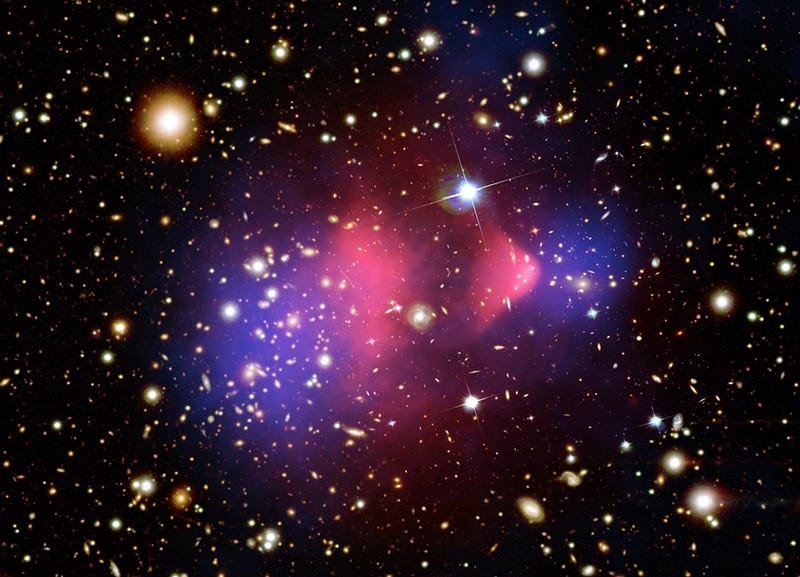
Lensing Map: NASA/STScI; ESO WFI; Magellan/U.Arizona/ D.Clowe et al.;
Optical: NASA/STScI; Magellan/U.Arizona/D.Clowe et al.
The dark matter from the two clusters should pass right through one another, because dark matter doesn’t collide with normal matter or photons, as should the stars within the galaxies. (The stars not colliding is because the cluster collision is like firing two guns loaded with bird-shot at one another from 30 yards away: every single pellet should miss.) But the diffuse gas should heat up when they collide, radiating energy away in the X-ray (shown in pink) and losing momentum. In the Bullet Cluster, above, that’s exactly what we see.
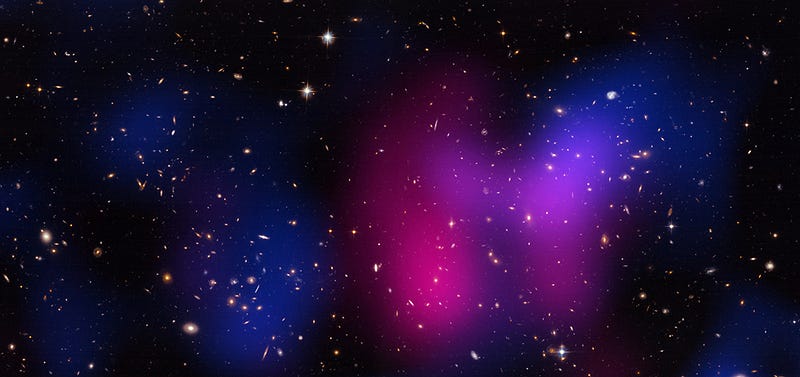
Ditto for the Musket Ball Cluster, a slightly older collision than the Bullet Cluster, that’s just recently analyzed. But others are more complicated; cluster Abell 520, for example, below, is still being scrutinized, as the source of gravitational lensing doesn’t appear to be 100% correlated with where the mass is expected to be.

If we look at the individual components, you can see where the galaxies are (which is also where the dark matter ought to be), as well as the X-rays, which tell us where the gas is, you’d expect the lensing data — which is sensitive to the mass (and hence, dark matter) — to reflect that.
But we can go to even smaller scales, and look at individual galaxies on their own. Because around every single galaxy, there should be a huge dark matter halo, comprising approximately 80% of the mass of the galaxy, but much larger and more diffuse than the galaxy itself.
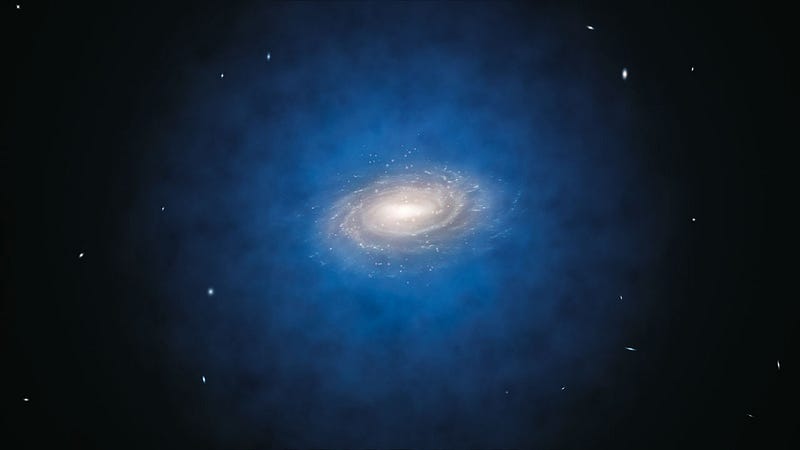
Whereas a spiral galaxy like the Milky Way might have a disc 100,000 light-years in diameter, its dark matter halo is expected to extend for a few million light-years! It’s incredibly diffuse because it doesn’t interact with photons or normal matter, and so has no way to lose momentum and form very dense structures like normal matter can.
What we don’t yet have any information about, however, is whether dark matter interacts with itself in some way. Different simulations give very different results, for example, as to what the density of one of these halos ought to look like.

If the dark matter is cold and doesn’t interact with itself, it should have either an NFW or a Moore-type profile, above. But if it is allowed to thermalize with itself, it would make an isothermal profile. In other words, the density doesn’t continue to increase as you get close to the core of a dark matter halo that’s isothermal.
Why a dark matter halo would be isothermal isn’t certain. Dark matter could be self-interacting, it could exhibit some sort of exclusion rule, it could be subject to a new, dark-matter-specific force, or something else that we haven’t thought of yet. Or, of course, it could simply not exist, and the laws of gravity that we know could simply need modification. On galactic scales, this is where MOND, the theory of Modified Newtonian Dynamics, really shines.
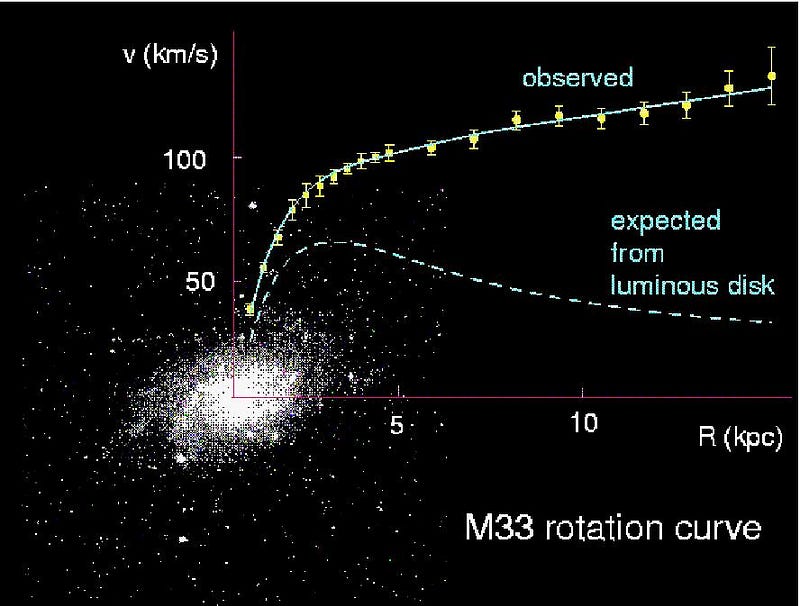
While the NFW and Moore profiles — the ones that come from the simplest models of Cold Dark Matter — don’t really match up with the observed rotation curves very well, MOND fits individual galaxies perfectly. The isothermal halos do a better job, but lack a compelling theoretical explanation. If we only based our understanding of the “missing mass” problem — whether there was extra, “dark” matter, or whether there was a flaw in our theory of gravity — on individual galaxies, I would likely side with the MOND-ian explanation.
So when you see a headline like Serious blow to dark matter theories?, you already have a hint that they’re looking at individual galaxies. Let’s look at one from two years ago as an example.

A team of researchers took a look at stars relatively close to our solar neighborhood, and looked for evidence of this inner distribution of mass from the theoretical dark matter halo. You’ll notice, looking a couple of images up, that only the simplest, completely collision-less models of Cold Dark Matter give that large effect in the cores of dark matter halos.
So let’s take a look at what the survey shows.

Indeed, the simple (NFW and Moore) halo profiles are highly disfavored, as many studies before have shown. Although this is interesting, because it demonstrates their insufficiency on these small scales in a new way.
So you ask yourself, do these small-scale studies, the ones that favor modified gravity, allow us to get away with a Universe without dark matter in explaining large-scale structure, the Lyman-alpha forest, the fluctuations in the cosmic microwave background, or the matter power spectrum of the Universe? The answers, at this point, are no, no, no, and no. Definitively. Which doesn’t mean that dark matter is a definite yes, and that modifying gravity is a definite no. It just means that I know exactly what the relative successes and remaining challenges are for each of these options. It’s why I unequivocally state that modern cosmology overwhelmingly favors dark matter over modified gravity, and that was before the binary pulsar measurements ruled out the most viable possibility of modified gravity.

But I also know — and freely admit — exactly what it will take to change my scientific opinion of which one is the leading theory. And you’re free to believe whatever it is you like, of course, but there are very good reasons why the modifications to gravity that one can make to have gravity succeed so well without dark matter on galactic scales fail to address the other observations without also including dark matter.
And we know what it isn’t: it isn’t baryonic (normal matter), it isn’t black holes, it isn’t photons, it isn’t fast-moving, hot stuff, and it probably isn’t simple, standard, cold and non-interacting stuff either, like most WIMP-type theories hope for.

I think it’s likely to be something more complicated than the leading theories of today. Which isn’t to say that I think I know exactly what dark matter is or how to find it. I’m even sympathetic to certain degrees of skepticism expressed on that account; I don’t think I would claim to be 100% certain that dark matter is right and our theories of gravity are also right until we can verify dark matter’s existence more directly. But, if you want to reject dark matter, there’s a whole host of things you’ll need to explain some other way. Don’t completely ignore large-scale structure and the need to address it; that’s a surefire way to fail to earn my respect, and the respect of every cosmologist who studies it.
And that’s, as best as I can express it in a single blog post, the whole story on dark matter. I’m sure there are plenty of comments; let the fireworks begin!
Have your say and weigh in at the Starts With A Bang forum on Scienceblogs!





